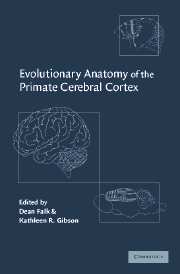Book contents
- Frontmatter
- Contents
- List of contributors
- Preface
- Prologue: Size matters and function counts
- Part I The evolution of brain size
- Part II Neurological substrates of species-specific adaptations
- Introduction to Part II
- 7 The discovery of cerebral diversity: an unwelcome scientific revolution
- 8 Pheromonal communication and socialization
- 9 Revisiting australopithecine visual striate cortex: newer data from chimpanzee and human brains suggest it could have been reduced during australopithecine times
- 10 Structural symmetries and asymmetries in human and chimpanzee brains
- 11 Language areas of the hominoid brain: a dynamic communicative shift on the upper east side planum
- 12 The promise and the peril in hominin brain evolution
- 13 Advances in the study of hominoid brain evolution: magnetic resonance imaging (MRI) and 3-D reconstruction
- 14 Exo-and endocranial morphometrics in mid-Pleistocene and modern humans
- Epilogue: The study of primate brain evolution: where do we go from here?
- Index
14 - Exo-and endocranial morphometrics in mid-Pleistocene and modern humans
Published online by Cambridge University Press: 07 October 2011
- Frontmatter
- Contents
- List of contributors
- Preface
- Prologue: Size matters and function counts
- Part I The evolution of brain size
- Part II Neurological substrates of species-specific adaptations
- Introduction to Part II
- 7 The discovery of cerebral diversity: an unwelcome scientific revolution
- 8 Pheromonal communication and socialization
- 9 Revisiting australopithecine visual striate cortex: newer data from chimpanzee and human brains suggest it could have been reduced during australopithecine times
- 10 Structural symmetries and asymmetries in human and chimpanzee brains
- 11 Language areas of the hominoid brain: a dynamic communicative shift on the upper east side planum
- 12 The promise and the peril in hominin brain evolution
- 13 Advances in the study of hominoid brain evolution: magnetic resonance imaging (MRI) and 3-D reconstruction
- 14 Exo-and endocranial morphometrics in mid-Pleistocene and modern humans
- Epilogue: The study of primate brain evolution: where do we go from here?
- Index
Summary
In hominid evolution, the shape of the inner frontal bone in the median sagittal plane has, in contrast to the outer vault, not changed since at least the Plio-Pleistocene (Bookstein et al., 1999). Nonetheless, inner vault size increased significantly (by ∼ 11%) while the size of the outer frontal profile did not. Thus, two of the more interesting questions to pose are: ‘At which other positions of the skull have major shape and size changes taken place?’ and ‘Could it be that the exocranium is involved in shape changes while the endocranium is involved in size changes?’. We approach these questions by analyzing general shape and size of both the exo- and endocranium in the median sagittal plane. Importantly, because the inner surface of the braincase provides information concerning brain evolution (Jerison, 1973) and because of the synevolution of cerebellar and frontal lobes (Seidler et al., 1997), our investigation also includes the occipital bone.
Geometric relations in the median-sagittal plane
Our sample includes 21 crania of modern humans of both sexes (10 females, 11 males): 15 from Central Europe, two San and two Bantu, and two Papuans. To these we added the stereolithographs of three mid- Pleistocene fossil hominid crania (Seidler et al., 1997): Kabwe (Broken Hill 1; Woodward, 1921), Petralona (Kokkoros & Kanellis, 1960), both of uncertain age – but probably in excess of 200 000 years old; and Atapuerca SH5 cranium (Arsuaga et al., 1993), about 300 000 years old.
- Type
- Chapter
- Information
- Evolutionary Anatomy of the Primate Cerebral Cortex , pp. 290 - 304Publisher: Cambridge University PressPrint publication year: 2001
- 1
- Cited by

